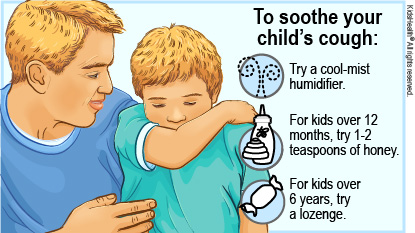Influenza: How to Care for Your Child
Influenza, also known as "the flu," is an infection caused by a virus. Your child stayed in the hospital for care and is now ready to go home. Most kids with the flu feel better in about a week, but some feel tired and weak for a few weeks after having the flu.
Sometimes the flu causes more serious problems, especially in young children and children with other medical problems (such as asthma, HIV, or diabetes). Getting the flu vaccine every year helps protect kids from the flu.


-
Follow your health care provider’s instructions for giving any prescribed medicines.
-
Give acetaminophen (Tylenol® or a store brand) or ibuprofen (Advil®, Motrin®, or a store brand) for fever, sore throat, or body aches. Read the package label and follow the instructions on how much to give and how often to give it.
-
Do not give aspirin to your child or teen as it has been linked to a rare but serious illness called Reye syndrome.
-
Do not give cough or cold medicines to children under 6 years old because they can cause bad reactions. Only give these medicines to children over 6 years old if your health care provider says it’s OK.
-
Let your child rest as needed.
-
Offer your child plenty of liquids. Babies can continue to breastfeed or take formula.
-
To soothe your child's cough:
-
Run a cool-mist humidifier in your child's bedroom. Clean after each use.
-
If your child is older than 12 months, it's OK to give 1–2 teaspoons of honey at night. If your child is under 12 months old, do not give honey.
-
To help with a runny or stuffy nose:
-
Run a cool-mist humidifier in your child's bedroom. Clean after each use.
-
For babies: Put a few drops of saline (saltwater) into the nose, then gently suction the mucus out with a bulb syringe. Do this no more than 2–3 times a day so that the inside of your baby's nose does not get swollen or sore.
-
For older kids: Give 2 sprays of saline nose spray 3 times a day.
-
Your child can return to school and activities when they:

Your child:
-
has symptoms that are getting worse (such as cough or headache)
-
has new symptoms (such as ear pain)
-
does not feel better in 3–4 days or is getting sicker
-
has a fever that returns after being fever-free for 24 hours
-
appears dehydrated; signs include dizziness, drowsiness, a dry or sticky mouth, sunken eyes, crying with few or no tears, or peeing less often/having fewer wet diapers

Your child:
-
has trouble breathing; signs include fast breathing, the muscles pulling in between the ribs, or the nose puffing out with each breath
-
gets a stiff neck
-
seems very sleepy or confused

How does the flu spread? The flu spreads easily from person to person. It can spread when a person with the flu coughs and/or sneezes the virus into the air and someone else breathes it in. It also can spread when someone touches the influenza virus on another person or a hard surface (such as a doorknob), and then touches their own eyes, nose, or mouth.
Your child may still spread influenza up to 10 days after getting sick. To help reduce the spread of influenza and other viruses, teach kids to:
-
Sneeze into a tissue, if possible, then throw the tissue away and wash their hands well. If a tissue is not available, they should sneeze into their upper sleeve or inner elbow, not their hands.
-
Wash hands well and often with soap and water and scrub for at least 20 seconds. This is especially important after coughing or sneezing. If soap and water are not available, they can use a hand sanitizer with at least 60% alcohol.
How can we prevent the flu? The best way to prevent the flu is to get the flu vaccine every year. Although a child who gets the flu vaccine still might get the flu, the illness is likely to be less serious.
Is there treatment for the flu? Antiviral medicines are available to treat the flu. Health care providers may prescribe antiviral medicine for a very ill child, very young children, children with some types of medical conditions (such as asthma, HIV, or diabetes), or kids who might get problems from the flu. The medicine can shorten the illness by 1–2 days. It only works if children start taking it within 48 hours of the start of the flu.
Antibiotics will not treat the flu because the flu is caused by a virus. Antibiotics only work against bacteria, not viruses.